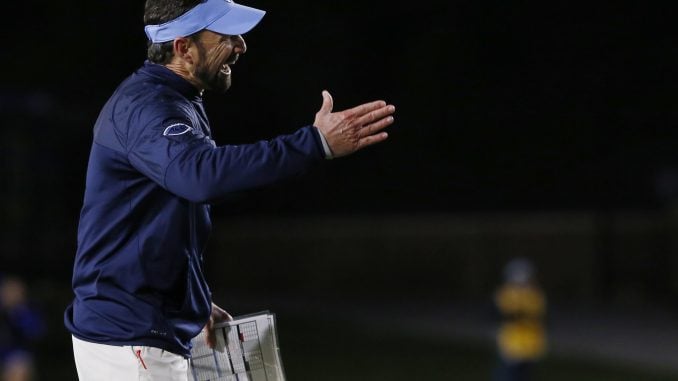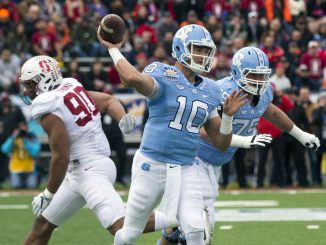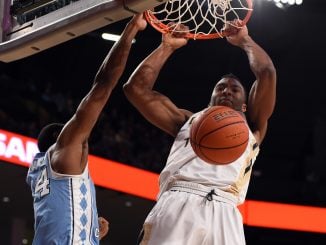
North Carolina knew Duke was suffering from injury problems this year, but the Tar Heels had no idea how bad it was until they showed up for the game between the two teams.When Carolina arrived at Wallace Wade Stadium for the nationally televised game against Duke, the Heels discovered that the Blue Devils’ senior cornerback Breon Borders was in street clothes and on crutches during warmups.Duke was forced to start true freshman Mark Gilbert in Borders’ spot.Once Carolina was aware of the personnel change, the Heels targeted Gilbert in the passing game. The freshman held up, however, and Duke ended up upsetting the Heels.Afterward, Gilbert was asked when he found out he’d be starting in place of Borders.”Well, he got hurt last week,” Gilbert said. “So I started getting ready then, just in case. Then, this week, he didn’t practice at all.”That was a surprising development, indeed, especially for anyone that read the injury report released by Duke, two days before the game.The ACC policy states that teams will release an injury report following “the end of practice on Thursday, or two days prior to the next football game (Tuesday for Thursday game, Thursday for Saturday).”The injury report must be released within 90 minutes of the end of practice, and “injured players’ playing status for the school’s next football game will be announced in one of four categories: a. Probable b. Questionable c. Doubtful d. Out.Borders wasn’t included on Duke’s report, despite not practicing during the week.ACC Associate Commissioner for Football Communications Mike Finn offered one potential explanation for the omission. “Keep in mind that a player’s injury status can change in the 48 hours between the release of this [injury report] and the actual game.”Coach David Cutcliffe added more information on Borders’ injury following the game.”It was kind of mystical,” he said. “Leg injury soft tissue. We’re a little bit shocked. He’s been imaged. The image suggests he’s going to get better but he didn’t get better quickly. We were kind of shocked. We were hoping. We had hoped as of yesterday he might play. Then he woke up this morning and didn’t feel good at all.”Despite Finn’s suggestion that Borders may have taken a turn for the worse just before the game, it appears that Duke was hopeful but unsure of his availability all week, which sounds like a pretty solid working definition for “probable” or “questionable”.Of course, it would have been tough for North Carolina to get on a soap box about Duke’s incomplete injury report. On October 20, the Tar Heels announced that guard Caleb Peterson and linebacker Jonathan Smith would miss the rest of the season, after injuries sustained the week before the team’s game against Virginia Tech. The school’s release stated that Smith had been injured in practice that week. Peterson was a surprise game-time scratch from the starting lineup against the Hokies.Neither player was included on the injury report prior to Virginia Tech, however. Both were listed as questionable the following week, against Miami, before getting ruled out for the season a week later.While Carolina may not have known for sure that Peterson and Smith were lost for the season, unless both injuries occurred during a Friday pregame walk-through, they should have been included on the report as probable, questionable or doubtful.Following Elijah Hood’s 168-yard rushing day against Georgia Tech, coach Larry Fedora raved about his junior running back. “Somebody asked me this week how Hood is, and I said he’s as close to 100 percent as he’s been all year,” Fedora said. “That means going all the way back to camp. He’s really feeling good now. He’s feeling like he’s 100 percent. … I think the biggest thing for him, it’s been frustrating for him, mentally. He hasn’t been 100 percent, so he hasn’t done the things that he’s wanted to do.”Despite battling injury and being less than 100 percent “going all the way back to camp,” Hood appeared on the injury report exactly twice, in the two weeks after leaving the Florida State game early.Remarkably, while these examples seem to imply that there is rampant cheating going on with ACC injury reports, the fact is it’s all perfectly legal.Fans are likely familiar with NFL injury reports, which are heavily regulated by rules requiring completeness and accuracy. Determination of whether a player is doubtful or questionable is based on his participation in practice, and teams caught in an injury report lie face fines. The Ravens, Redskins and Bills have all been fined in recent years, and Patriots coach Bill Belichick’s long-running attempts to circumvent reporting injuries accurately, which include leaving injured players off and including virtually the entire roster on the report to bury true injuries, have led the league to rewrite the rule to close loopholes.None of that is true in the ACC.”First of all, it’s not a rule,” Finn explained. “It’s a guideline that our coaches decided on. There is no enforcement.”The official ACC policy says exactly that. It begins:”Approved by the ACC’s Football Head Coaches, the guideline goes into effect beginning with the Monday prior to the first game of the season. This guideline is not an ACC rule and is a suggested minimum standard guideline for release of injury information. ACC Injury Release Guideline This policy is suggested guideline for the 2016 football season. This is not an ACC rule subject to enforcement.” Not only that, but there is a strong incentive for coaches to be less than forthcoming in their injury reports. It may seem paranoid for coaches to worry that opponents are examining their injury reports and press conferences in search of a nugget of information to give them an edge, but that’s exactly what’s going on.”Oh yeah, definitely,” Fedora admitted. “We have people who do that, and comb the internet for anything that’s out there for someone who takes a picture in practice, and if there’s anything we can see in that picture.”Clearly, with a few extra days to prepare for the possibility that Gilbert would start for Borders, Fedora and his staff could have designed a game plan to take advantage of his inexperience, rather than simply altering the in-game playcalling. It’s not outside the realm of possibility to argue that leaving Borders off may have helped Duke win the game.So there is no incentive for coaches to be open, complete and accurate with their weekly injury report, and, in fact, a strong incentive not to be.That leads to an obvious conclusion: Why release an injury report at all? If the league can’t monitor and enforce the accuracy of injury reports, either because coaches won’t agree to it or because there isn’t enough manpower to devote to it, then perhaps it would be best to eliminate them altogether.Until something changes, fans, media and gamblers are getting the illusion of information.



